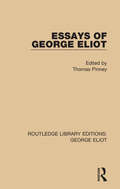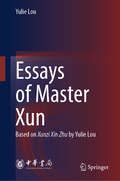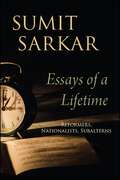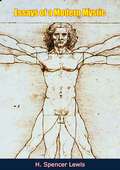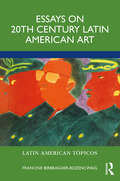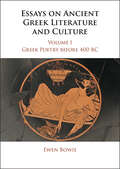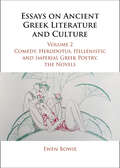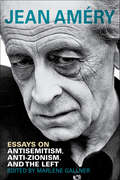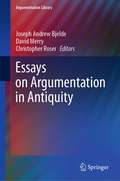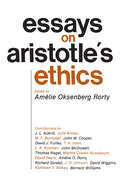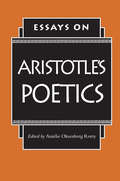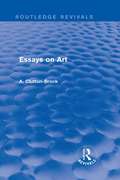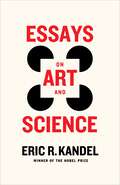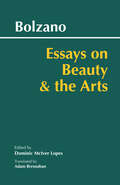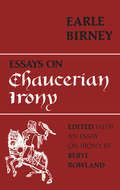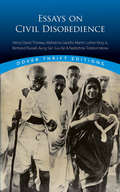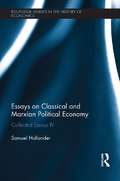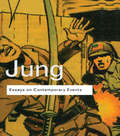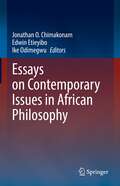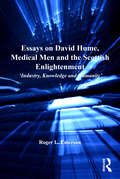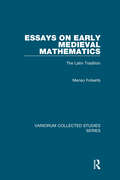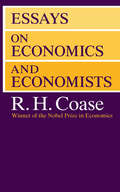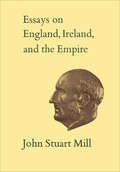- Table View
- List View
Essays of George Eliot (Routledge Library Editions: George Eliot)
by Thomas PinneyThis collection, first published in 1963, includes 29 of George Eliot’s essays written between 1846 and 1868. Through these essays, Pinney has managed to convey her range of subject-matters and variety of style. This title, with an introduction and footnotes written by the editor, will be of particular interest to students of literature.
Essays of Master Xun: Based on Xunzi Xin Zhu by Yulie Lou
by Yulie LouThis is the first book written by Chinese scholars with more accurate interpretation of Master Xun’s philosophy and quoted texts from other Chinese classics. Master Xun is one of the greatest Confucian philosophers of the classical period in China. His thought has been exercising a profound impact on ideology, academic research, social and political system, ritual and moral principles, as well as the practical aspects of personal self-cultivation, education and learning. After reading the book, the readers will understand thoroughly the ancient Chinese philosophy.
Essays of a Lifetime: Reformers, Nationalists, Subalterns (SUNY series in Hindu Studies)
by Sumit SarkarA distillation of the historian's finest writings on modern Indian historical themes.For the past forty years or more, the most influential, respected, and popular scholar of modern Indian history has been Sumit Sarkar. When his first monograph, The Swadeshi Movement in Bengal 1903–1908, appeared in 1973 it soon became obvious that the book represented a paradigm shift within its genre. As Dipesh Chakrabarty put it when the work was republished in 2010: "Very few monographs, if any, have ever rivalled the meticulous research and the thick description that characterized this book, or the lucidity of its exposition and the persuasive power of its overall argument."Ten years later, Sarkar published Modern India 1885–1947, a textbook for advanced students and teachers. Its synthesis and critique of everything significant that had been written about the period was seen as monumental, lucid, and the fashioning of a new way of looking at colonialism and nationalism.Sarkar, however, changed the face not only of modern Indian history monographs and textbooks, he also radically altered the capacity of the historical essay. As Beethoven stretched the sonata form beyond earlier conceivable limits, Sarkar can be said to have expanded the academic essay. In his hands, the shorter form becomes in miniature both monograph and textbook.The present collection, which reproduces many of Sarkar's finest writings, shows an intellectually scintillating, skeptical-Marxist mind at its sharpest.
Essays of a Modern Mystic
by H. Spencer LewisThe contents of these essays touch the fundamentals of human interest, such as birth, man’s mission, his concern with the afterlife, and practical problems of ethics and morals. The author writes as though he were personally counseling one who came to his study for advice as did several thousand persons during his lifetime.Dr. Lewis was the executive officer of the Rosicrucian Order, AMORC, one of the world’s oldest and largest fraternities devoted to mystical and metaphysical study. Thousands have read and benefited from his books.This book you will want to refer to often. Though you will find it interesting, it is intended to be helpful and informative. For this reason you will find it a useful reference work pertaining to the mysteries of human existence.
Essays on 20th Century Latin American Art (Latin American Tópicos)
by Francine Birbragher-RozencwaigEssays on 20th Century Latin American Art provides a broad synthesis of the subject through short chapters illustrated with reproductions of iconic works by artists who have made significant contributions to art and society. Designed as a teaching tool for non-art historians, the book's purpose is to introduce these important artists within a new scholarly context and recognize their accomplishments with those of others beyond the Americas and the Caribbean. The publication provides an in-depth analysis of topics such as political issues in Latin American art and art and popular culture, introducing views on artists and art-related issues that have rarely been addressed. Organized both regionally and thematically, it takes a unique approach to the exploration of art in the Americas, beginning with discussions of Modernism and Abstraction, followed by a chapter on art and politics from the 1960s to the 1980s. The author covers Spanish-speaking Central America and the Caribbean, regions not usually addressed in Latin American art history surveys. The chapter on Carnival as an expression of popular culture is a particularly valuable addition. This book will be of interest to students and scholars of Latin American history, culture, art, international relations, gender studies, and sociology, as well as Caribbean studies.
Essays on Ancient Greek Literature and Culture
by Ewen BowieIn this book one of the world's leading Hellenists brings together his many contributions over four decades to our understanding of early Greek literature, above all of elegiac poetry and its relation to fifth-century prose historiography, but also of early Greek epic, iambic, melic and epigrammatic poetry. Many chapters have become seminal, e.g. that which first proposed the importance of now-lost long narrative elegies, and others exploring their performance contexts when papyri published in 1992 and 2005 yielded fragments of such long poems by Simonides and Archilochus. Another chapter argues against the widespread view that Sappho composed and performed chiefly for audiences of young girls, suggesting instead that she was a virtuoso singer and lyre-player, entertaining men in the elite symposia whose verbal and musical components are explored in several other chapters of the book. Two more volumes of collected papers will follow devoted to later Greek literature and culture.
Essays on Ancient Greek Literature and Culture: Volume 2, Comedy, Herodotus, Hellenistic and Imperial Greek Poetry, the Novels
by Ewen BowieIn this book one of the world's leading Hellenists brings together his many contributions over four decades to our understanding of major genres of Greek literature, above all the Greek novel, but also Attic Comedy, fifth-century historiography, and Hellenistic and Imperial Greek poetry. Many are already essential reading, such as the chapter on the figure of Lycidas in Theocritus' Idyll 7, or two chapters on the ancient readership of Greek novels. Discussions of Imperial Greek poetry published three decades ago opened up a world almost entirely neglected by scholars. Several chapters address literary and linguistic issues in Longus' novel Daphnis and Chloe, complementing the author's commentary published in 2019; two contribute to a better understanding of the enigmatic Aethiopica of Heliodorus; and many explore important questions arising from examination of the form of the Greek novel as a whole. This is the second of a planned three-volume collection.
Essays on Antisemitism, Anti-Zionism, and the Left (Studies in Antisemitism)
by Jean AméryIn April 1945, Jean Améry was liberated from the Bergen Belsen concentration camp. A Jewish and political prisoner, he had been brutally tortured by the Nazis, and had also survived both Auschwitz and other infamous camps. His experiences during the Holocaust were made famous by his book At the Mind's Limits: Contemplations by a Survivor of Auschwitz and Its Realities.Essays on Antisemitism, Anti-Zionism, and the Left features a collection of essays by Améry translated into English for the first time. Although written between 1966 and 1978, Améry's insights remain fresh and contemporary, and showcase the power of his thought.Originally written when leftwing antisemitism was first on the rise, Améry's searing prose interrogates the relationship between anti-Zionism and antisemitism and challenges the international left to confront its failure to think critically and reflectively.
Essays on Argumentation in Antiquity (Argumentation Library #39)
by Joseph Andrew Bjelde David Merry Christopher RoserThis book provides a collection of essays representing the state of the art in the research into argumentation in classical antiquity. It contains essays from leading and up and coming scholars on figures as diverse as Parmenides, Gorgias, Seneca, and Classical Chinese "wandering persuaders." The book includes contributions from specialists in the history of philosophy as well as specialists in contemporary argumentation theory, and stimulates the dialogue between scholars studying issues relating to argumentation theory in ancient philosophy and contemporary argumentation theorists. Furthermore, the book sets the direction for research into argumentation in antiquity by encouraging an engagement with a broader range of historical figures, and closer collaboration between contemporary concerns and the history of philosophy.
Essays on Aristotle's Ethics (Philosophical Traditions #2)
by Amélie Oksenberg RortyAristotle's Nicomachean Ethics deals with character and its proper development in the acquisition of thoughtful habits directed toward appropriate ends. The articles in this unique collection, many new or not readily available, form a continuos commentary on the Ethics. Philosophers and classicists alike will welcome them.
Essays on Aristotle's Poetics
by Amélie Oksenberg RortyAimed at deepening our understanding of the Poetics, this collection places Aristotle's analysis of tragedy in its larger philosophical context. In these twenty-one essays, philosophers and classicists explore the corpus of Aristotle's work in order to link the Poetics to the rest of his views on psychology and on history, ethics, and politics. The essays address such topics as catharsis, pity and fear, pleasure, character and the unity of action, and the modality of dramatic action. In addition to the editor, the contributors are Elizabeth Belfiore, Rdiger Bittner, Mary Whitlock Blundell, Wayne Booth, Dorothea Frede, Cynthia Freeland, Leon Golden, Stephen Halliwell, Richard Janko, Aryeh Kosman, Jonathan Lear, Alexander Nehamas, Martha C. Nussbaum, Deborah Roberts, G.E.M. de Ste. Croix, Nancy Sherman, Jean-Pierre Vernant, Stephen A. White, and Paul Woodruff.
Essays on Art (Routledge Revivals)
by A. Clutton-BrockThis collection of brief but insightful essays, though always returning to the author’s central conviction that the quality of artistic endeavour depends not on individuals of genius but on the attitude of the public towards art itself, examines a wide variety of unique but related issues: the relationship between natural and artistic beauty; the genius of Da Vinci and Nicholas Poussin; the influence of femininity on European art; the importance of good criticism; art as a social phenomenon; the role of the passions; and a range of associated topics. First published in 1919, A. Clutton-Brock’s reflections on the nature and function of art bear the marks of the deep anxieties following the First World War, and can thus speak to a generation similarly faced with uncertainty.
Essays on Art and Science
by Eric R. KandelWhen we view a work of art, we often experience an emotional response, but the causes of our reactions are complex. Our knowledge of why we respond to art as we do is rooted in science—in psychology and biology. Eric R. Kandel traces the origins of this understanding to early twentieth-century Vienna, which gave rise to the concept of the “beholder’s share,” the realization that art is incomplete without the perceptual and emotional involvement of the viewer—that is, without our responses to it.But what causes our response? Our brain is a creativity machine that brings to bear on any image—including a painting—certain innate, universal processes related to sensory perception as well as higher-order processes related to our personal experiences, memories, and emotions. Understanding how these unconscious processes in the brain interact to create the beholder’s share is one of the great challenges currently confronting brain science.The essays on art and science in this book vary widely in subject matter, including the angst-ridden portraits of Soutine, conflicting views of women’s sexuality, Cubism’s challenge to our innate visual processes, and why we react differently to abstract versus figurative art. But each essay focuses on the interaction of art and science. Woven throughout are the many notable scientists, art historians, artists, and others, both Jewish and non-Jewish, who contributed to our understanding of how we experience art.
Essays on Beauty and the Arts (Hackett Classics)
by Bernard BolzanoBernard Bolzano&’s (1781–1848) writings in aesthetics are clear, concise, and explicit about method. Provocative and revisionary, they champion broad views of beauty, the arts, and their social function. Dominic McIver Lopes's introductory materials place Bolzano's essays in context, give them a new interpretation, and map out how to teach them, in full or in part, in a variety of courses.
Essays on Chaucerian Irony
by Earle Birney Beryl RowlandThese essays, written between 1937 and 1960, have remained classics of their kind. They include important discussions on irony--its native traditions and its occurrence in early English literature, an account of critics' appreciation of Chaucerian irony prior to this century, and a detailed examination of four of the Canterbury Tales. The illuminating analysis of the complex use of various kinds of irony in the Miller's Tale, the Friar's Tale, the Summoner's Tale, and the Manciple's Tale emphasizes aspects of Chaucer's art that are very acceptable to contemporary. As a result, these essays lead today's reader towards a fuller understanding of Chaucer's achievement.
Essays on Civil Disobedience (Dover Thrift Editions)
by Bob BlaisdellInexpensive but substantial, this anthology ranges from Henry David Thoreau's great nineteenth-century polemics "Civil Disobedience" and "Slavery in Massachusetts" to more recent writings by Aung San Suu Kyi as well as Nadezhda Tolokonnikova of the subversive Russian rock group Pussy Riot.Additional selections include Leo Tolstoy's denouncement of capital punishment, "I Cannot Be Silent"; Bertrand Russell's "Civil Disobedience and the Threat of Nuclear Warfare"; and "Love, Law, and Civil Disobedience" and "Letter from Birmingham City Jail" by Martin Luther King, Jr. Other contributors include William Lloyd Garrison, Albert Einstein, and Aleksandr Solzhenitsyn. Editor Bob Blaisdell provides an informative Introduction.
Essays on Classical and Marxian Political Economy: Collected Essays IV (Routledge Studies in the History of Economics)
by Samuel HollanderSamuel Hollander’s work has been provoking debate for over four decades. This book brings together key contributions of recent years, in addition to some brand new pieces. The essays are introduced by a Preface in which Hollander reflects on his past work and reactions to it. Highlights include two issues of particular current relevance. Conspicuous is an extensive chapter regarding Adam Smith’s often neglected arguments for government intervention in the economy to correct market failures, and his critical view of the business class as an anti-social force. Important economists considered in relation to Adam Smith’s position on the role of the state include Jeremy Bentham and the Scottish-Canadian John Rae. Similarly of high present-day interest is a re-examination of Karl Marx’s theory of exploitation, or the notion of profits as "embezzlement," demonstrating Marx’s effective abandonment of this perspective in the case of the small active businessman as distinct from the major joint-stock corporation. Other papers demonstrate the close intellectual relationship between David Ricardo and Thomas Robert Malthus; the extensive common ground between the British school and the French under the leadership of Jean-Baptiste Say; the failure of a so-called anti-Ricardian opposition in Britain represented by Samuel Bailey; and the denial of a sharp discontinuity between "classical" and later "neo-classical" economics. Finally, several biographical essays are included as well as an extension of the autobiographical account appearing in Collected Essays II.
Essays on Contemporary Events (Routledge Classics)
by C. G. JungWas the leading psychologist of his time a Nazi sympathiser? This was the question asked by many after the Second World War, as they sought to explain Jung's actions and publications during Nazi rule. So great was the controversy that his reputation risked being permanently damaged. Essays on Contemporary Events was the first broadside in his vigorous defence of his beleaguered reputation. This remarkable work is essential reading for anyone seeking to understand Jung. It will enable the reader to decide: was Jung wholly innocent of the accusations or had he, like so many others, fallen under the Nazi spell and was now trying to make amends.
Essays on Contemporary Issues in African Philosophy
by Jonathan O. Chimakonam Edwin Etieyibo Ike OdimegwuThis volume is a collection of chapters about contemporary issues within African philosophy. They are issues African philosophy must grapple with to demonstrate its readiness to make a stand against some of the challenges society faces in the coming decade such as xenophobia, Afro-phobia, extreme poverty, democratic failure and migration. The text covers new methodical directions and there is focus on the conversationalist, complementarist and consolationist movements within the field as well as the place of the Indigenous Knowledge System.The collection speaks to African philosophy’s place in intellectual history with coverage of African Ethics and African socio-political philosophy. Contributors come from a variety of different backgrounds, institutions and countries. Through their innovative ideas, they provide fresh insight and intellectual energy. The book appeals to philosophy students and researchers.
Essays on David Hume, Medical Men and the Scottish Enlightenment: 'Industry, Knowledge and Humanity' (Science, Technology And Culture, 1700-1945 Ser.)
by Roger L. EmersonThe Scottish Enlightenment was a period of intellectual and scientific progress, in a country previously considered to be marginal to the European intellectual scene. Yet the enlightenment was not about politeness or civic humanism, but something more basic - the making of an improved society which could compete in every way in a rapidly changing world. David Hume, writing in 1752, commented that 'industry, knowledge and humanity are linked together by an indissoluble chain'. Collectively this volume of essays embraces many of the topics which Hume included under 'industry, knowledge and humanity': from the European Enlightenment and the Scots relation to it, to Scottish social history and its relation to religion, science and medicine. Overarching themes of what it meant to be enlightened in the eighteenth century are considered alongside more specific studies of notable figures of the period, such as Archibald Campbell, 3rd Duke of Argyll, and David Hume, and the training and number of Scottish medical students. Together, the volume provides an opportunity to step back and reconsider the Scottish Enlightenment in its broader context and to consider what new directions this field of study might take.
Essays on Early Medieval Mathematics: The Latin Tradition
by Menso FolkertsThis book deals with the mathematics of the medieval West between ca. 500 and 1100, the period before the translations from Arabic and Greek had their impact. Four of the studies appear for the first time in English. Among the topics treated are: the Roman surveyors (agrimensores); recreational mathematics in the period of Bede and Alcuin; geometrical texts compiled in Corbie and Lorraine from Latin sources from late antiquity; the abacus at the time of Gerbert (pope Sylvester II.); and a board-game invented in the first half of the 11th century (the 'Rithmimachia') to help people to learn mathematics. Included in the volume are critical editions of several texts, e.g. that of Franco of Liège on squaring the circle, Bede and Alcuin on recreational mathematics, and part of Pseudo-Boethius' Geometry I. The book opens with a survey of mathematics in the Middle Ages, and ends with a history of Rithmimachia up to the 17th century, when the game fell into disuse.
Essays on Economics and Economists
by R. H. CoaseReflections on two centuries of economic history from a Nobel Prize winner in the field: &“An accessible collection by a renowned economist.&”—Library Journal How do economists decide what questions to address and how to choose their theories? How do they tackle the problems of the economic system and give advice on public policy? With these broad questions, Nobel laureate R. H. Coase, widely recognized for his seminal work on transaction costs, reflects on some of the most fundamental concerns of economists over the past two centuries. In fifteen essays, Coase evaluates the contributions of a number of outstanding figures, including Adam Smith, Alfred Marshall, Arnold Plant, Duncan Black, and George Stigler, as well as economists at the London School of Economics in the 1930s. &“Are you looking for a book by an economist who can really write and has insight after insight on free markets vs. government regulation? Would you like it even better if you could get some good laughs from his clever way of putting things? Then Ronald H. Coase&’s Essays on Economics and Economists is the book for you.&”—Reason
Essays on Eddic Poetry
by John Mckinnell Donata Kick John ShaferEssays on Eddic Poetry presents a selection of important articles on Old Norse literature by noted medievalist John McKinnell. While McKinnell's work addresses many of the perennial issues in the study of Old Norse, this collection has a special focus on the interplay between heathen and Christian world-views in the poems.Among the texts examined are Hávamál, which includes an elegantly cynical poem about Óðinn's sexual intrigues and a more mystical one about his self-sacrifice on the world-tree in order to gain magical wisdom; Vǫlundarkviða, which recounts an elvish smith's revenge for his captivity and maiming; and Hervararkviða, where the heroine bravely but foolishly raises her dead father to demand the deadly sword Tyrfingr from him.Originally published between 1988 and 2008, these twelve essays cover a wide range of mythological and heroic poems and have been revised and updated to reflect the latest scholarship.
Essays on Education in the Early Republic
by Robert Coram Frederick Rudolph Benjamin Rush Noah Webster Samuel Harrison Smith Amable-Louis-Rose De Lafitte Du Courteil Samuel Knox Simeon DoggettOnly a relatively few colonial Americans received any formal education beyond the elementary subjects. Secondary schools were rare. Private tutors and the local clergyman carried the main burden of college preparation. There were public secondary schools in New England, a few private schools in the middle colonies, and even fewer in the South--all of them concentrating on the Latin that led to college and a career in one of the learned professions. Nine colleges of varying degrees of stability and age carried on in the New World the collegiate traditions of Oxford and Cambridge. Several of these institutions were barely able to prove their existence before the American Revolution gave a new twist to their fortunes.
Essays on England, Ireland, and Empire: Volume VI
by John Stuart Mill John Robson Joseph HamburgerJohn Stuart Mill's political essays are a blend of the practical and the theoretical. In this volume are gathered together those in which the practical emphasis is more marked; those in which theory is predominant are found in Essays on Politics and Society, Vols XVIII and XIX of the Collected Works. The Essays on England, Ireland, and the Empire are mainly from Mill's early career as a propagandist for the Philosophic Radicals (a term he himself coined). They provide a contemporary running account of British political issues at home and abroad, with a vigorous and sometimes acerbic commentary. Historians as well as political scientists will find interesting details of the view from the radical side, and all students of Mill will welcome the further elucidation of his development. Of special interest are his precocious if tendentious attack on Hume's History of England, and his reactions to Canadian and Irish issues, the latter being the subject of a previously unpublished manuscript. The textual apparatus includes a collation of the manuscript materials and identification of Mill's quotations and references.
